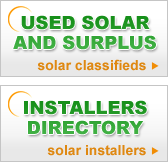
By Chick Jacobs
Staff writer
The light has always been there. The trick was keeping it around after
sunset.
Now, advances in technology, batteries and the general willingness of
homeowners to “do it themselves” have sparked a new crop
of solar-powered home-lighting solutions.
Before that, the words “solar lighting” were reserved for
dim glimmers of light that marked walkways — for a few hours after
sunset, anyway. And heaven help the person who needed their guidance
after a cloudy afternoon.
Low-powered accent lights have been available for years, offering a
variety of styles, powers and costs. Spotlights and floodlights —
known as “task lighting” by experts — have taken longer
to arrive.
Due to the iffy reputation of high-powered solar lighting, homeowners
were understandably reluctant to count on it for security. The cost
saved in installation was countered with expensive lights and batteries
and the ongoing uncertainty of sunlight.
All a crook had to do was wait for a cloudy day, then proceed without
fear that night.
Now a day without sunshine doesn’t mean a night without light.
Solar batteries store more energy, and some can operate up to three
days without the sun.
And thank goodness manufacturers have finally realized that solar collectors
don’t need to be stuck to the light. The squarish collectors are
connected to lights by wires of up to 16 feet, meaning the light can
shine in shady areas while gathering sunlight elsewhere.
Solar lighting isn’t perfect, despite shining brighter and longer.
Here are five questions to keep in mind before taking the solar plunge:
What are you lighting? There are two primary types of solar floodlight:
floodlights and spotlights. Both are excellent for security, but they
serve different functions.
Spotlights shine a smaller, constant beam into a focused area regardless
of motion. Think of them as flashlights, pointing into the night.
Floodlights, as the name implies, cast a flood of light into an area
whenever movement triggers the light. The light isn’t as bright,
and it generally turns off after 60 or 90 seconds.
How much light will you need? While solar panels and batteries are less
expensive than in the past, they’re still pricey — especially
if you’re talking about a lot of light.
If that’s the case, remember that even the strongest solar light
can’t match the power of a hard-wired beam. If you need several
floodlights, or extra-bright light, you might be better off getting
an electrician to install traditional floodlights.
LED or halogen? These are the two types of bulb used by solar lights.
Halogen bulbs produce extra light for the same amount of energy, while
LED (light-emitting diode) bulbs last much longer. Most solar lights
use LED, but floodlights generally use halogen bulbs. Make sure you’re
getting what you want before you buy.
Where’s the sun? It seems strange making sure where the sun shines
before dealing with the dark, but the more sunlight you can feed your
light, the longer you’ll have light. Make sure the light you’re
buying includes enough wire to place the solar collector in a sunny
spot.
For the best result, experts suggest placing the collector on the south-facing
roof, perpendicular to the sun — and where there’s no shade,
of course.
Do I really want to “do it myself?” Sure, sunlight is free.
But if you don’t enjoy getting up on the roof or wiggling around
on a ladder, is free energy worth the hassle?
Staff writer Chick Jacobs can be reached at jacobsc@fayettevillenc.com
or 486-3515.
http://www.fayettevillenc.com/article?id=237483

